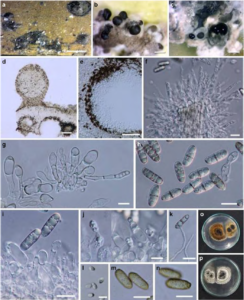Roussoella magnatum D.Q. Dai & K.D. Hyde.
Index Fungorum number: IF551342; Facesoffungi number: FoF00902; Fig. 1
Etymology – The he Latin, magna, meaning large, about the large conidiomata.
Holotype – MFLU 15–1213
Saprobic on bamboo culms, forming dark spots on the host surface, with pustule-like raised conidiomata. Sexual morph: Undetermined. Asexual morph: Conidiomata 2 – 3 mm long, 1 – 2 mm wide, 300 – 500 μm high, eustromatic, immersed in the host tissue, partly erumpent when mature, solitary, scattered, multi – loculate, ellipsoid to wide – fusiform, coriaceous, with fissure – like ostiole. Conidiomatal wall thin, 15 – 30 μm wide, with dark brown to hyaline, conidiogenous, inner layer, comprising cells of textura angularis. Paraphyses 45 – 80 μm long, 2 – 5.5 μm wide, hyaline, septate, straight to flexuous, wide at base. Conidiophores 6 – 15.5 × 4 – 7 μm (x̄ = 12.1 × 5.1 μm, n = 10), cylindrical, subglobose to irregular, smooth, hyaline, occasionally branched. Conidiogenous cells 5 – 22 × 2.5 – 7 μm (x̄ = 12.6 × 4.8 μm, n = 20), enteroblastic, phialidic, cylindrical to subglobose, or ampulliform, determinate, discrete, smooth, hyaline. Macroconidia 16.5 – 21 × 5.5 – 6 μm (x̄ = 18.9 × 5.6 μm, n = 20), pale brown to dark brown, 1-septate, cylindrical, obtuse at both ends, occasionally truncate at the lower end, smooth to slightly warty, straight, with many guttules. Microconidia 2.5 – 4 × 1.5 – 2.5 μm (x̄ = 3.4 × 2.1 μm, n = 20), subglobose, hyaline, smooth, guttulate.
Culture characteristics – Ascospores germinating on PDA within 24 h and germ tubes produced from lower cell. Colonies growing slowly on PDA, reaching 5 mm in 60 days at 28 °C, circular, floccose, with uneven margin, white from above, yellowish brown to dark brown from below. Mycelium immersed and superficial in the media, composed of branched, septate, smoothwalled, hyaline aerial hyphae and verrucose, dark brown hyphae near or within the media, producing black conidial masses and subglobose to irregular conidiomata with multi-locules in the center and at the margin.
Material examined – THAILAND, Phang-Nga, Doi Nang Hong, Tham Thong Lang, Thap Put District, 8°32′11″N 98°33′35″E, on dead culm of bamboo, 6 December 2014, K.D. Hyde DDQ00282 (MFLU 15–1213, holotype); Ibid. (KUN, HKAS 88720, isotype), ex-type living culture at MFLUCC 15–0185, KUMCC.
Notes –Roussoella magnatum is characterized by large, black, eustromatic, el lipsoid to wide fusiform conidiomata, and dark, warty, 1 – septate conidia. This new taxon forms 2 – 3 × 1 – 2 mm conidiomata on the host. Such large conidiomata are not so far observed in any other species of Roussoella (Hyde et al. 1996; Liu et al. 2014).

Fig. 1 Roussoella magnatum (holotype) a Conidiomata on bamboo culms b, c Conidiomata in culture d Conidiomata after cutting away top part e Conidiogenous inner layer f, g Conidiogenous cells h – j Paraphyses k – n Conidia o Germinated conidium p Conidia q, r Cultures on PDA after 60 days. Scale bars: a – c = 1 mm, d = 100 μm, e = 50 μm, f – k, m, n = 10 μm, l = 5 μm.
